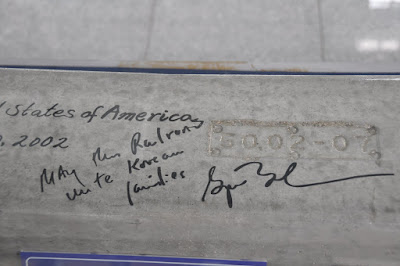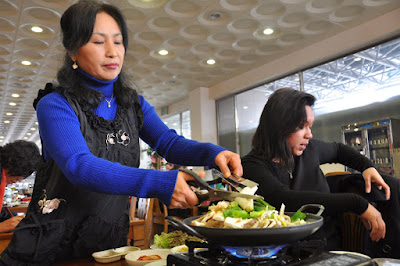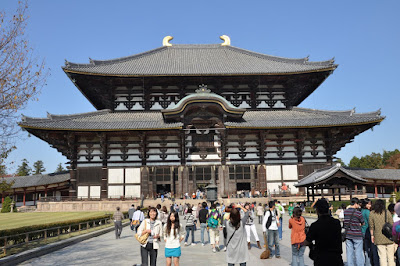Mochi is basically sticky rice pounded into a paste, available anywhere in Japan and something I enjoy almost weekly. But this was the first time I actually made the mochi. I think the best way to tour around the party is to show the steps in making Mochi.
Step 1: prepare the rice, I really did not pay to much attention back here, I think you wash the rice and place it in cheesecloth.
 Step 2: cook the rice, not as easy as it sounds. The rice is cooked by passing steam through the cheesecloth. First you have to make a stove from bricks and feed the fire with wood planks, the bottom level of pans above the fire is boiling water. The two levels above is the rice and the smoke is mostly steam.
Step 2: cook the rice, not as easy as it sounds. The rice is cooked by passing steam through the cheesecloth. First you have to make a stove from bricks and feed the fire with wood planks, the bottom level of pans above the fire is boiling water. The two levels above is the rice and the smoke is mostly steam. Step 3: pick a hammer.
Step 3: pick a hammer. Step 4: remove the ball of cooked rice from the cheesecloth and put it in a large wooded mortar. The first step is to grind the rice with the hammer.
Step 4: remove the ball of cooked rice from the cheesecloth and put it in a large wooded mortar. The first step is to grind the rice with the hammer. Step 5: is by far the most fun. Basically you pound the rice, with the larger hammers, you can feel the ground shake 15 feet away. There are actually two people taking part in step 5, one is pounding the rice, the second is keeping the rice damp and folding it over between hammering. In the photo below you can see the person with her hand in the water. She is getting ready to put her hand between the rice and the hammer after I'm done crushing it (rice). This seem kind of dangerous to me.
Step 5: is by far the most fun. Basically you pound the rice, with the larger hammers, you can feel the ground shake 15 feet away. There are actually two people taking part in step 5, one is pounding the rice, the second is keeping the rice damp and folding it over between hammering. In the photo below you can see the person with her hand in the water. She is getting ready to put her hand between the rice and the hammer after I'm done crushing it (rice). This seem kind of dangerous to me. Step 6: After the pounding, the rice paste is made in to little balls and at this point it is ready to eat. You can cover or fill the mochi with anything, in this case there is some red bean and organic fruits.
Step 6: After the pounding, the rice paste is made in to little balls and at this point it is ready to eat. You can cover or fill the mochi with anything, in this case there is some red bean and organic fruits. Step 7: enjoy!
Step 7: enjoy! The party was held in the city of Manazuru, about 2 hours southwest from Tokyo, there was a great view over looking Manazuru bay, which is the Pacific Ocean.
The party was held in the city of Manazuru, about 2 hours southwest from Tokyo, there was a great view over looking Manazuru bay, which is the Pacific Ocean. There is also farms everywhere, many organic. Many of the farms grow mikan, kind of like small orange, below is mikan storage at the farm after picking.
There is also farms everywhere, many organic. Many of the farms grow mikan, kind of like small orange, below is mikan storage at the farm after picking.
I took the bullet train to return home and had to wait for a little while at Atami station. Here are a couple of photos of the bullet train passing through the station:
 It's going about 150mph...
It's going about 150mph...







































